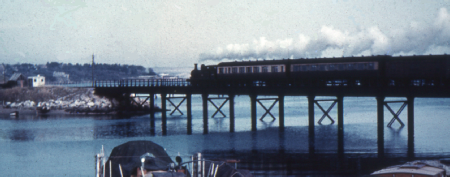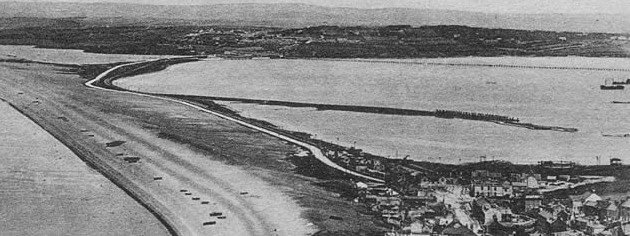Chesil Beach and the Fleet Lagoon
18 miles and 180 billion pebbles


The Portland branch railway ran from near Weymouth station to Victoria Square on Portland and from there up to Easton on the top of the island. For part of the way it ran the whole length of Hamm Beach as depicted in the print below. This shows the original wooden railway viaduct on the left and the original wooden road bridge on the right.

The wooden railway viaduct was replaced in 1902 with a metal structure and the picture right shows this viaduct which was in use up until the line closed in 1965.
From the viaduct across the Fleet the line continued southwards on a raised trackbed to what is now the channel for the Chiswell drainage channel. The railway then continued south adjacent to the road into Victoria Square while the Hamm Beach tombolo swung eastwards towards the eastern side of the island as can be seen in this old postcard.


The railway opened in 1857 and closed to passengers in 1952 but continued with goods traffic until 1965. Just before it closed several special passenger trains were put on and the picture below shows one of these trains on the Hamm Beach embankment heading for Portland.

The scene now is somewhat different. The pebbles are advancing towards the road, the railway and oil tanks have gone and the sailing academy has been built. The naval base is now a civilian port hosting large liners.

The railway trackbed is now lost under the boatyard at Ferrybridge and under the development of the old Heliport south of the flood channel. The remaining trackbed is now a unique habitat because of the granite ballast on a drained embankment with ditches either side.



The embankment is now a blend of mini coastal habitats created by the construction of the line and running in parallel with it. In heaping up beach material to form the embankment, near permanently wet and dry environments can be recognised by the plant communities present within them. Saltmarsh species, including the rare shrubby sea-blite and pockets of reed, reflect the presence of brackish water in the ditches. Grassland species cover the dry banks. The embankment was topped with granite ballast stones amongst which grow toadflax and Oxford ragwort, species often associated with railway lines. Another railway line traveller, the common lizard, lives here too. Where the embankment is or has been disturbed patches of bramble and teasel and seaside annuals exist.
For more information on the Portland Railway, Brian Jackson has written an excellent book on the history of the line.
Jackson,B.L. Isle of Portland Railways Vol 2: Weymouth and Portland Railways and the Easton and Church Ope Railway. Oakwood Library of Railway History, ISBN 0 85361 551 9. 2000.











